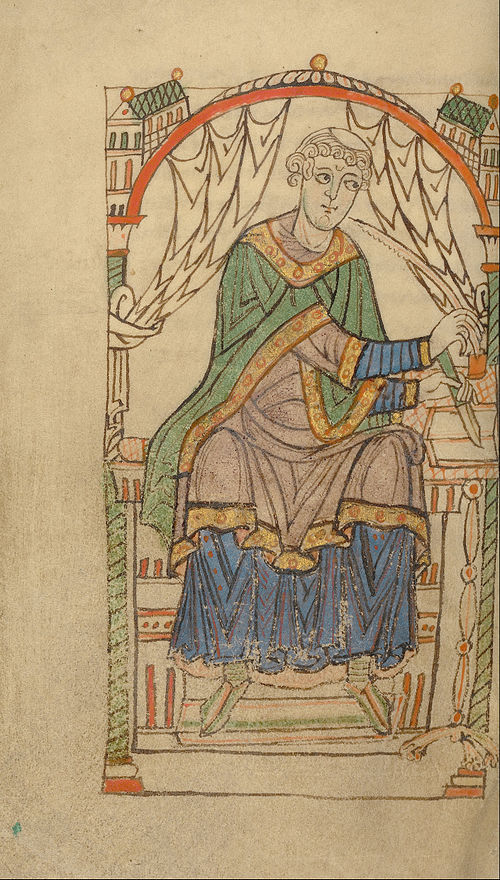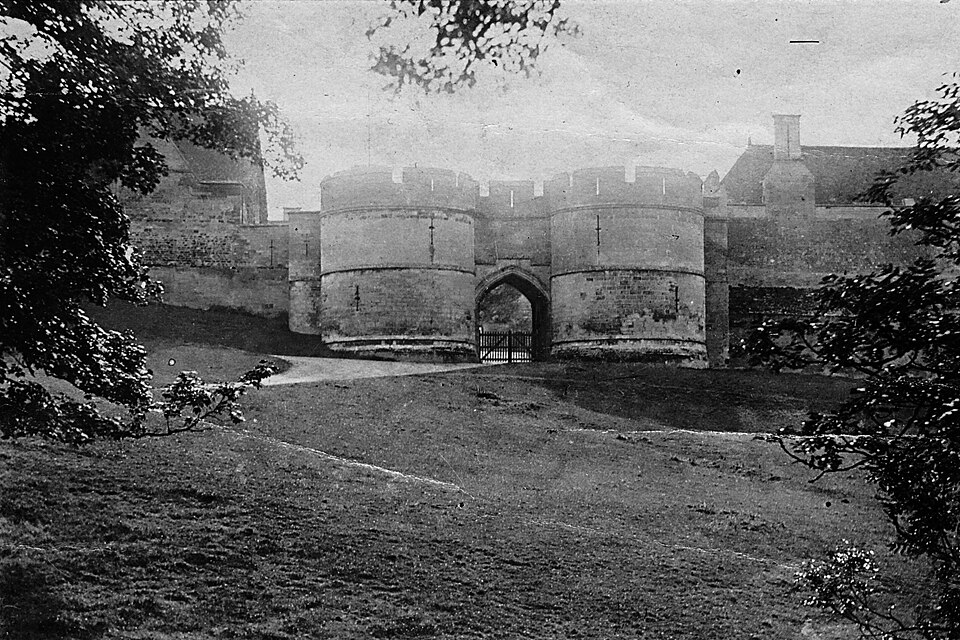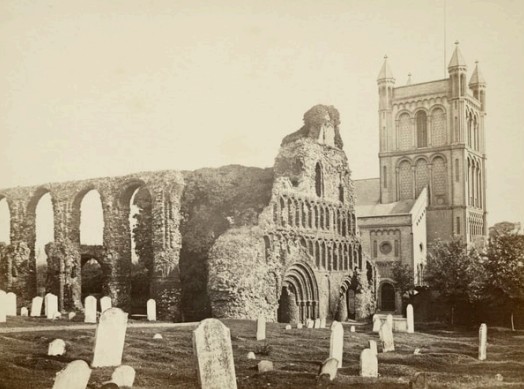OCR Specification focus:
‘the Council of Rockingham (1095); the spread of monasticism, including the Augustinians’
Monasticism and ecclesiastical reform under William II were shaped by political disputes, evolving religious practices, and the introduction of new monastic orders into England’s ecclesiastical landscape.
The Council of Rockingham (1095)
The Council of Rockingham was a pivotal event in William II’s reign, centred on his confrontation with Anselm, the Archbishop of Canterbury, over ecclesiastical authority and the king’s rights.

Miniature from Life and Conversation of Anselm of Canterbury showing the archbishop in instruction with monks. It illustrates Anselm’s authority and the learned culture underpinning ecclesiastical reform. The decorative border and gold ground are artistic features not required by the syllabus but help situate Anselm in his period. Source
Background to the Dispute:
Anselm’s appointment in 1093 came during a period of strained crown–Church relations. William’s control over episcopal appointments was a key point of contention.Papal Allegiance:
The council arose partly due to disagreements over whether Anselm should acknowledge Pope Urban II without William’s consent.
This reflected the wider Investiture Controversy, a Europe-wide dispute over whether secular rulers or the papacy should appoint bishops.The Council’s Proceedings:
Held in March 1095 at Rockingham Castle.

Rockingham Castle’s Norman gateway, representing the kind of fortified environment that hosted the 1095 council between William II, Anselm, bishops and nobles. The image supports the geopolitical tone of the meeting and the king’s assertion of secular authority. Some architectural details visible today post-date 1095, which is extra information beyond the syllabus. Source
Attended by bishops and lay nobles.
William sought to pressure Anselm into submission by rallying support among his clergy.
The meeting was inconclusive, with Anselm appealing to Rome for papal intervention.
Aftermath:
Papal envoys mediated a compromise. Urban II was recognised as pope, but William retained considerable control over the Church in England.
Investiture Controversy: The conflict between secular and papal powers over who held the authority to appoint bishops and abbots.
The Spread of Monasticism
Under William II, monastic life in England expanded despite the king’s often tense relationship with ecclesiastical leaders.
Existing Monastic Traditions
Before William II, England’s religious life was shaped mainly by Benedictine monasticism, characterised by strict adherence to the Rule of St Benedict and close ties to royal authority.
Monasteries were centres of:
Religious devotion and prayer.
Learning, manuscript production, and preservation of texts.
Agricultural innovation and land management.
The Arrival of the Augustinians
One of the most significant developments was the introduction of the Augustinian canons into England.
Origins:
The Augustinians followed the Rule of St Augustine, which combined communal monastic life with active pastoral work in surrounding communities.Differences from Benedictines:
Whereas Benedictines were primarily cloistered, Augustinians engaged directly with parishioners, serving as priests and educators.Establishment in England:
Augustinian houses began to be founded in the late 11th century, partly reflecting continental reform movements that sought to revitalise the Church’s pastoral mission.

Ruins of St Botolph’s Priory, Colchester, the first Augustinian house in Britain, founded around 1100. The alternating stone and re-used Roman brick demonstrate typical early Norman construction techniques. The page includes extra historical detail (e.g., later damage and guardianship) that goes beyond the syllabus focus. Source
Impact:
Expanded clerical presence in rural areas.
Strengthened parish structures.
Contributed to moral and disciplinary reforms among clergy.
Rule of St Augustine: A set of guidelines for religious communities emphasising communal living, pastoral care, and service to the wider Church.
Ecclesiastical Reform Efforts
Although William II was not personally devout and often clashed with ecclesiastical authorities, his reign still witnessed notable reforms and religious developments.
Reform Drivers
Continental Influence:
Reform ideals from Normandy and beyond encouraged stricter discipline among clergy and reduced secular interference in monastic affairs.Papal Reform Agenda:
Urban II and other reformist popes sought to standardise liturgy, enforce clerical celibacy, and strengthen canonical discipline.Role of Anselm:
As Archbishop of Canterbury, Anselm was a committed reformer, advocating for:Higher moral standards for clergy.
Greater independence for the Church from royal control.
Expansion of religious houses and pastoral outreach.
Outcomes and Limitations
Positive Outcomes:
Foundation of new monasteries and Augustinian priories.
Greater emphasis on pastoral care and moral reform.
Enhanced intellectual life within monastic centres.
Limitations:
William’s reluctance to relinquish control over ecclesiastical appointments curtailed papal influence.
Royal taxation and appropriation of Church revenues hindered some monastic expansion.
Conflicts like Rockingham slowed reform progress.
The Broader Context
William II’s reign must be understood in the context of:
Dynastic Politics: Ongoing tensions with his brother Robert Curthose and the Norman nobility influenced how William managed the Church to secure loyalty.
European Reform Movements: The Gregorian Reform movement was transforming the Church across Europe, affecting England through figures like Anselm and the arrival of the Augustinians.
Economic Pressures: Royal financial demands sometimes clashed with monastic ideals of poverty and self-sufficiency.
Key Points
The Council of Rockingham exemplifies William II’s determination to assert royal authority over ecclesiastical matters.
The spread of monasticism, particularly the arrival of the Augustinians, signalled a shift towards more active pastoral engagement in England.
Ecclesiastical reform under William II was shaped by both continental influence and internal political constraints.
Anselm’s role as a reformer was significant but often frustrated by the king’s priorities.
The reign reflected the broader Investiture Controversy, with England’s Church caught between papal reformist agendas and royal control.
FAQ
While papal recognition was central, the deeper issues included William II’s insistence on controlling the symbols of episcopal authority, his demand for loyalty over obedience to Rome, and disputes over whether clergy could appeal to the pope without royal consent.
Anselm’s desire to implement papal reforms challenged the king’s authority, making the conflict as much about power as theology.
It mirrored the ongoing Investiture Controversy in continental Europe, where monarchs and the papacy clashed over episcopal appointments.
The English situation was distinctive because William II sought to acknowledge the pope selectively, ensuring papal legitimacy while maintaining royal supremacy in church governance.
Their rule encouraged active ministry alongside monastic discipline, meeting pastoral needs in growing towns and rural parishes.
They could operate in both urban and rural settings, adapting to England’s mixed settlement patterns.
Their continental networks meant they brought reformist ideals directly from centres of change in Europe.
Competition for land and resources with existing Benedictine monasteries.
Navigating royal control over land grants and endowments.
Integrating into a church hierarchy where bishops were often political appointees of the king.
Ensuring their pastoral approach was accepted alongside traditional monastic customs.
In the short term, it reinforced William II’s control, as he avoided a clear papal victory.
However, the involvement of papal envoys and eventual compromise set precedents for negotiation rather than outright defiance, influencing later disputes under Henry I.
Practice Questions
Question 1 (2 marks)
In which year was the Council of Rockingham held, and who was the Archbishop of Canterbury involved in the dispute?
Question 1 (2 marks)
1 mark for identifying the correct year: 1095.
1 mark for naming the Archbishop of Canterbury: Anselm.
Question 2 (5 marks)
Explain two ways in which the arrival of the Augustinians contributed to ecclesiastical reform in England under William II.
Question 2 (5 marks)
Award up to 3 marks per explanation, maximum 5 marks in total.
Credit the following points (or other relevant and accurate responses):
Pastoral outreach: Augustinians combined monastic life with parish work, strengthening local pastoral care and religious instruction. (Up to 3 marks for detailed explanation linking this to reform).
Moral and disciplinary reform: Augustinians supported higher clerical standards and discipline, helping to address laxity among the clergy. (Up to 3 marks for detailed explanation linking this to wider reform movements).
Strengthening parish structures: Their presence increased the number of active clergy in rural areas, improving Church organisation. (Up to 3 marks, but cap total at 5).
Marks should be awarded for explanation, not just identification, with developed points linked to reform under William II.

